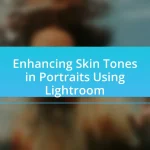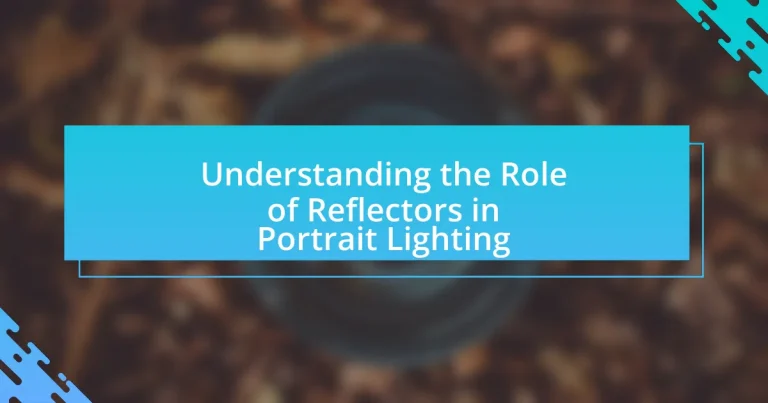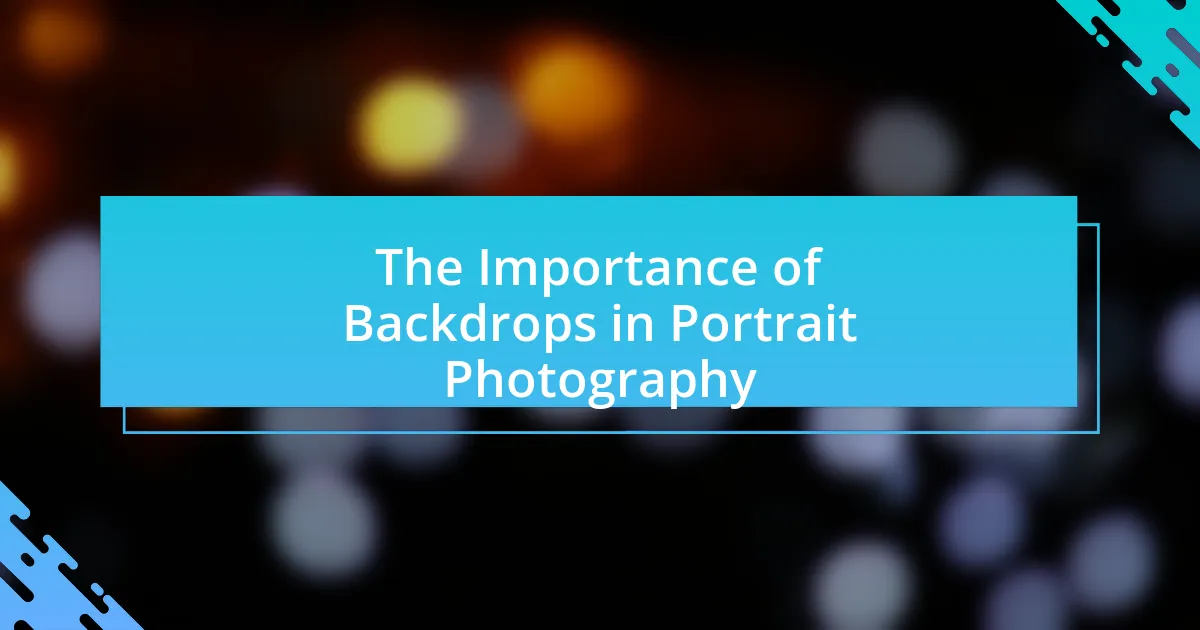Reflectors are essential tools in portrait lighting, used to bounce light onto subjects, enhance illumination, and reduce shadows. This article explores the various types of reflectors, including white, silver, gold, and black, and their impact on light quality and skin tone enhancement. It discusses how the size, shape, and material of reflectors influence lighting outcomes, as well as best practices for positioning them effectively during a shoot. Additionally, the article highlights common mistakes to avoid and techniques to control the intensity of reflected light, providing a comprehensive understanding of how to utilize reflectors to achieve professional-looking portraits.
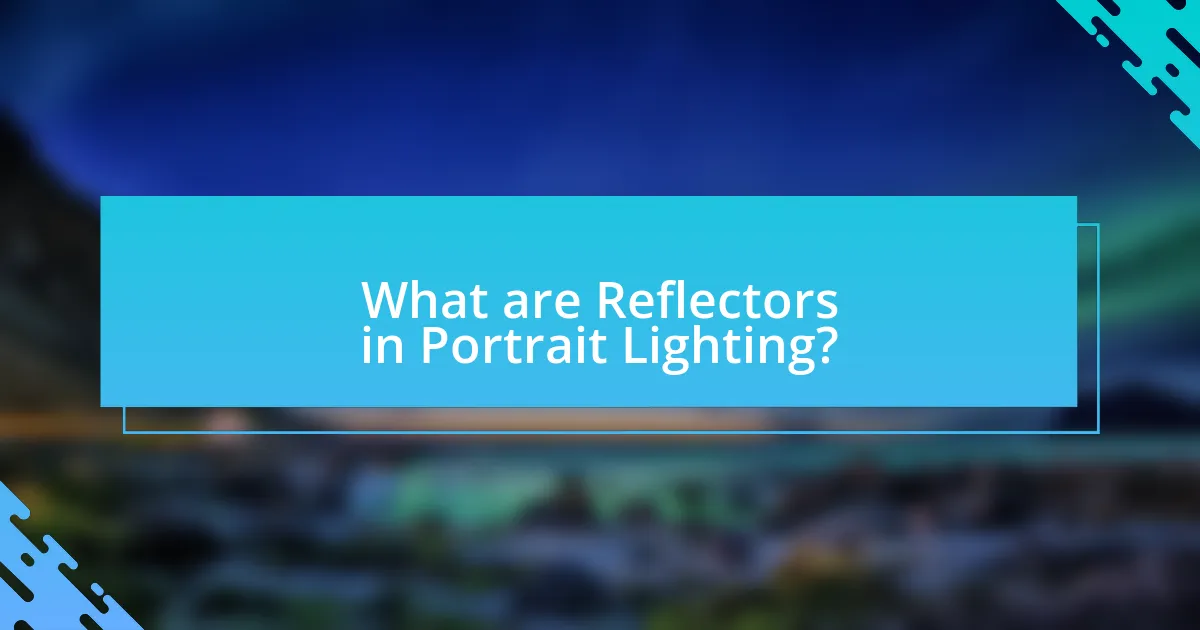
What are Reflectors in Portrait Lighting?
Reflectors in portrait lighting are tools used to bounce light onto a subject, enhancing illumination and reducing shadows. They come in various materials and colors, such as white, silver, and gold, each affecting the quality and warmth of the reflected light. The use of reflectors can significantly improve the overall lighting in a portrait, creating a more flattering and balanced appearance. Studies in photography emphasize that proper use of reflectors can lead to a more professional look by softening harsh lighting conditions and providing even light distribution across the subject’s face.
How do Reflectors influence the quality of light in portrait photography?
Reflectors influence the quality of light in portrait photography by redirecting and softening natural or artificial light onto the subject. This redirection enhances the overall illumination, reduces harsh shadows, and creates a more flattering light on the subject’s face. For instance, using a white reflector can produce a soft, diffused light that minimizes contrast, while a silver reflector can create a brighter, more specular highlight. Studies in photography emphasize that the use of reflectors can significantly improve the aesthetic quality of portraits by achieving a balanced light distribution, which is crucial for capturing details and textures in skin tones.
What types of reflectors are commonly used in portrait lighting?
Commonly used reflectors in portrait lighting include white, silver, gold, and black reflectors. White reflectors provide a soft, neutral bounce of light, enhancing skin tones without altering color. Silver reflectors create a more intense and cooler light, increasing contrast and brightness, which is useful for dramatic effects. Gold reflectors add warmth to the light, making them ideal for creating a sun-kissed look. Black reflectors, while not used for bouncing light, absorb it to create shadows and depth, allowing for more control over lighting dynamics. These types of reflectors are essential tools in portrait photography, as they help manipulate light to achieve desired effects and enhance the overall quality of the image.
How does the size of a reflector affect the lighting outcome?
The size of a reflector significantly influences the lighting outcome by determining the spread and intensity of light on the subject. Larger reflectors produce a broader and softer light, which reduces harsh shadows and creates a more flattering appearance, while smaller reflectors concentrate light into a tighter beam, resulting in more defined shadows and higher contrast. This effect is supported by the principles of light diffusion, where larger surfaces scatter light over a wider area, enhancing the overall illumination quality in portrait photography.
Why are Reflectors important in achieving desired lighting effects?
Reflectors are important in achieving desired lighting effects because they manipulate and redirect light to enhance the subject’s appearance. By bouncing light onto the subject, reflectors can fill in shadows, create highlights, and improve overall illumination, resulting in a more balanced and visually appealing image. Studies in photography demonstrate that using reflectors can significantly reduce harsh shadows and improve skin tone representation, making them essential tools for portrait lighting.
What role do reflectors play in reducing shadows?
Reflectors play a crucial role in reducing shadows by redirecting light towards the subject, thereby filling in dark areas. This technique enhances the overall illumination and creates a more balanced lighting effect in portrait photography. By reflecting light from a primary source, such as the sun or artificial lights, reflectors can soften harsh shadows and provide a more flattering appearance to the subject. Studies in photography demonstrate that using reflectors can significantly improve the quality of light, making it essential for achieving professional-looking portraits.
How can reflectors enhance skin tones in portraits?
Reflectors enhance skin tones in portraits by bouncing light onto the subject, which softens shadows and creates a more even illumination. This technique helps to highlight the natural hues of the skin, making tones appear more vibrant and reducing the appearance of blemishes. Studies in photography demonstrate that using reflectors can improve the overall quality of light, leading to more flattering images. For instance, a silver reflector can add a cool tone, while a gold reflector warms up the skin tones, allowing photographers to manipulate the mood and feel of the portrait effectively.
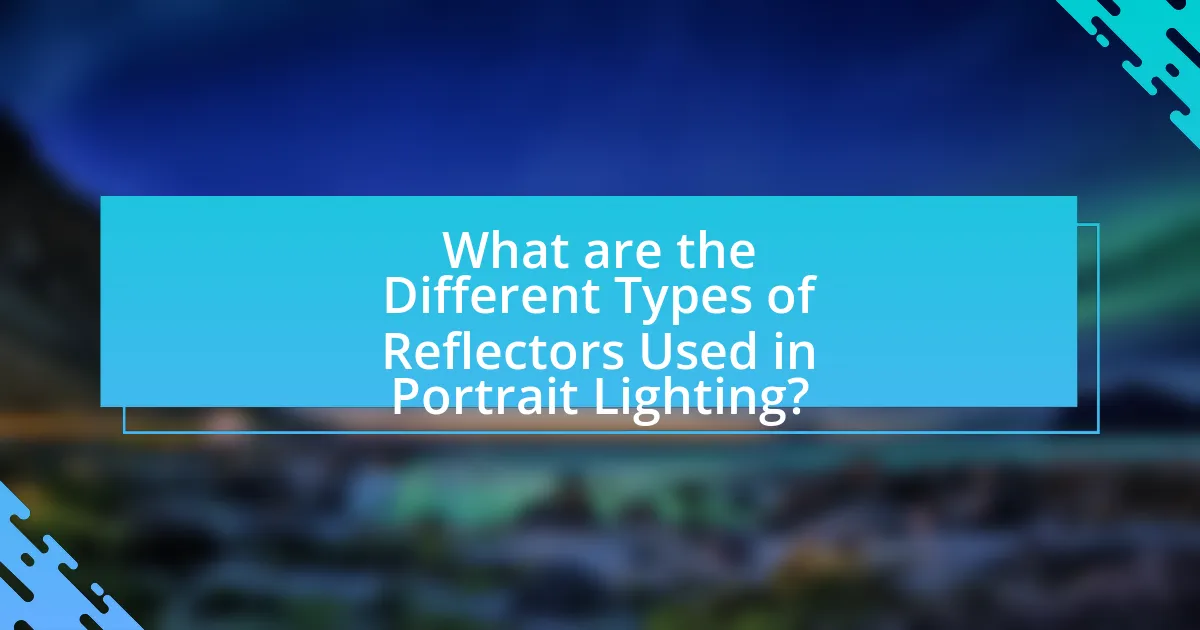
What are the Different Types of Reflectors Used in Portrait Lighting?
The different types of reflectors used in portrait lighting include white, silver, gold, black, and translucent reflectors. White reflectors provide a soft, neutral bounce of light, ideal for creating a natural look. Silver reflectors produce a more intense and specular light, enhancing contrast and brightness. Gold reflectors add warmth to the skin tones, making them suitable for portraits in cooler lighting conditions. Black reflectors absorb light, creating shadows and depth, which can be useful for dramatic effects. Translucent reflectors diffuse light, softening harsh shadows and providing a gentle illumination. Each type serves a specific purpose in shaping the quality and direction of light in portrait photography.
What materials are reflectors made from and how do they affect light?
Reflectors are commonly made from materials such as aluminum, mylar, and white or silver fabric. These materials influence light by reflecting it in various ways; for instance, aluminum and mylar provide high reflectivity, enhancing brightness and contrast, while white fabric offers a softer, diffused light. The choice of material directly affects the quality and direction of light, making it crucial for achieving desired effects in portrait lighting.
How does the color of a reflector influence the light it reflects?
The color of a reflector significantly influences the quality and hue of the light it reflects. Reflectors with different colors alter the light’s temperature and tone, affecting how subjects appear in portrait lighting. For instance, a white reflector produces neutral light, while a gold reflector adds warmth, creating a sun-kissed effect. Research indicates that colored reflectors can enhance skin tones and overall image aesthetics by modifying the light spectrum, thus impacting the final visual outcome in photography.
What are the advantages of using collapsible versus rigid reflectors?
Collapsible reflectors offer significant advantages over rigid reflectors, primarily in terms of portability and versatility. Collapsible reflectors can be easily folded and stored, making them ideal for photographers who need to transport equipment frequently. This portability allows for quick setup and adjustments in various shooting environments, enhancing the efficiency of portrait lighting. Additionally, collapsible reflectors often come in multiple surfaces, providing diverse lighting effects, which can be beneficial for achieving different artistic outcomes in portrait photography. In contrast, rigid reflectors, while providing stable and consistent light, lack the flexibility and ease of transport that collapsible options offer.
How do different shapes of reflectors impact lighting?
Different shapes of reflectors significantly impact lighting by altering the direction, intensity, and quality of light. For instance, circular reflectors produce a more even and diffused light, ideal for softening shadows in portrait photography. In contrast, rectangular reflectors create a more focused beam, which can enhance contrast and highlight specific features. Additionally, triangular reflectors can direct light into tight spaces, allowing for creative lighting angles. The effectiveness of these shapes is supported by the principles of light reflection, where the angle of incidence equals the angle of reflection, thus influencing how light interacts with subjects in a portrait setting.
What are the benefits of using circular reflectors compared to rectangular ones?
Circular reflectors provide more uniform light distribution compared to rectangular reflectors. This uniformity helps in reducing harsh shadows and creating a softer, more flattering light on the subject’s face, which is particularly beneficial in portrait lighting. Additionally, circular reflectors can be positioned at various angles more easily, allowing for greater versatility in lighting setups. Studies in photography have shown that the rounded shape of circular reflectors enhances the catchlights in the eyes, making portraits appear more engaging and lively.
How does the angle of a reflector change the lighting effect?
The angle of a reflector significantly alters the lighting effect by directing light towards the subject at varying intensities and angles. When a reflector is positioned closer to the subject and angled to bounce light directly onto it, the illumination becomes more intense and focused, enhancing details and creating a brighter appearance. Conversely, if the reflector is angled away or positioned further from the subject, the light becomes softer and more diffused, resulting in a gentler, more flattering effect. This principle is supported by the inverse square law, which states that light intensity decreases with distance; thus, the angle and distance of the reflector directly influence the quality and character of the light on the subject.
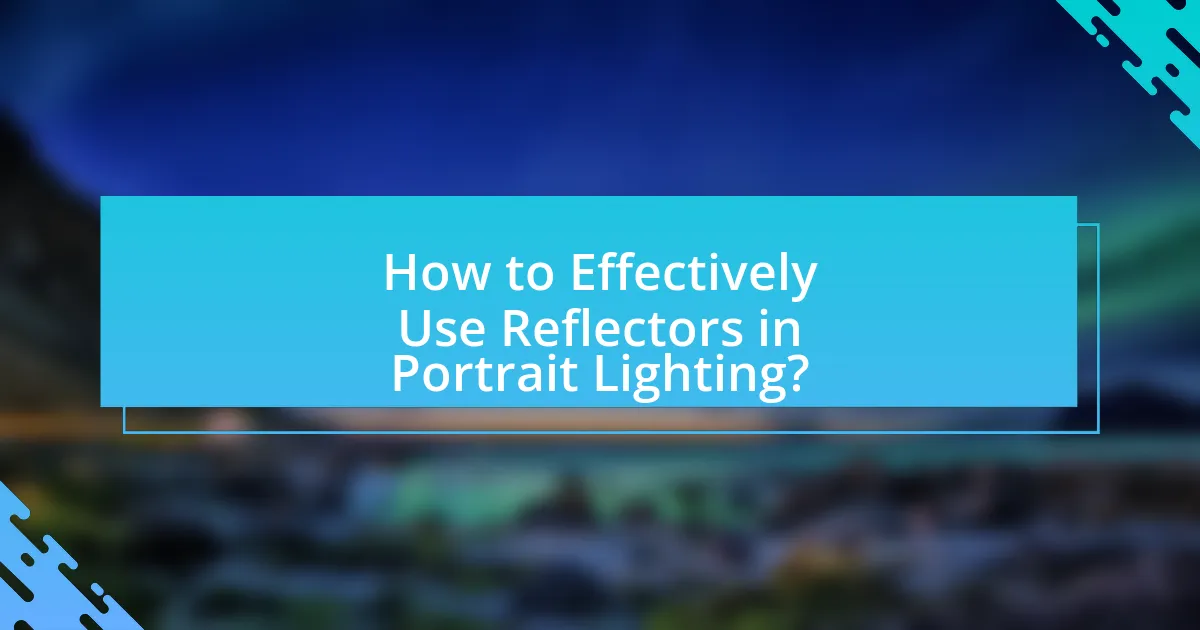
How to Effectively Use Reflectors in Portrait Lighting?
To effectively use reflectors in portrait lighting, position the reflector opposite the light source to bounce light onto the subject’s face. This technique softens shadows and enhances facial features, creating a more flattering appearance. For instance, using a white reflector can provide a natural fill light, while a gold reflector adds warmth to the skin tone. Studies in photography highlight that reflectors can increase the overall light on the subject by up to 50%, improving image quality significantly.
What are the best practices for positioning reflectors during a shoot?
The best practices for positioning reflectors during a shoot involve placing them at an angle that maximizes light bounce onto the subject’s face. Position the reflector approximately 45 degrees to the side and slightly below the subject’s eye level to create flattering highlights and reduce harsh shadows. This technique is supported by the principle that light travels in straight lines, and angling the reflector effectively directs the light where it is needed most. Additionally, using a larger reflector can enhance the softness of the light, making it more diffused and natural, which is crucial in portrait lighting.
How can you determine the optimal distance between the reflector and the subject?
To determine the optimal distance between the reflector and the subject, start by assessing the lighting effect desired on the subject’s face. The ideal distance typically ranges from 2 to 4 feet, as this allows for soft, diffused light that enhances facial features without harsh shadows. Research indicates that positioning the reflector closer to the subject increases light intensity and reduces shadows, while moving it further away softens the light but may diminish its effectiveness. Therefore, adjusting the distance based on the specific lighting conditions and the subject’s features will yield the best results.
What techniques can be used to control the intensity of reflected light?
Techniques to control the intensity of reflected light include adjusting the distance between the light source and the reflector, modifying the angle of the reflector, and using different materials or surfaces for the reflector. By increasing the distance, the intensity of the reflected light decreases due to the inverse square law, which states that light intensity diminishes with distance. Changing the angle of the reflector can direct more or less light onto the subject, allowing for precise control over the lighting effect. Additionally, using surfaces with varying reflectivity, such as matte versus glossy finishes, alters the quality and intensity of the reflected light, enabling photographers to achieve the desired lighting for portraiture.
What common mistakes should be avoided when using reflectors?
Common mistakes to avoid when using reflectors include improper positioning, which can lead to unflattering light angles, and using reflectors that are too small for the subject, resulting in uneven lighting. Additionally, failing to consider the color of the reflector can alter skin tones negatively; for instance, a gold reflector can create an unnatural warmth if not used judiciously. Over-reliance on reflectors without balancing with ambient light can also create harsh shadows. These mistakes can significantly impact the quality of portrait lighting, making it essential to understand and avoid them for optimal results.
How can improper use of reflectors lead to unflattering portraits?
Improper use of reflectors can lead to unflattering portraits by creating harsh shadows or uneven lighting on the subject’s face. When reflectors are positioned incorrectly, they can bounce light in a way that accentuates imperfections, such as wrinkles or blemishes, rather than softening them. For example, if a reflector is too close or angled improperly, it may produce a glare or overly bright spots, detracting from the overall image quality. Additionally, using reflectors with inappropriate surfaces, like shiny materials, can result in unwanted highlights that distort facial features.
What are the signs that a reflector is not being used effectively?
Signs that a reflector is not being used effectively include uneven lighting on the subject, lack of fill light in shadow areas, and harsh contrasts that do not enhance the portrait. When a reflector fails to create a balanced light, it can result in unflattering shadows or overly bright spots, indicating improper positioning or angle. Additionally, if the reflector does not match the color temperature of the main light source, it can create unnatural skin tones, further demonstrating ineffective use.
What tips can enhance the use of reflectors in portrait photography?
To enhance the use of reflectors in portrait photography, position the reflector at an angle that directs light onto the subject’s face, ensuring even illumination. This technique minimizes harsh shadows and creates a flattering light effect. Additionally, using different reflector surfaces—such as white for soft light, silver for increased brightness, and gold for warmth—can significantly alter the mood of the portrait. Studies show that proper reflector placement can improve the overall quality of light, making subjects appear more vibrant and three-dimensional.











